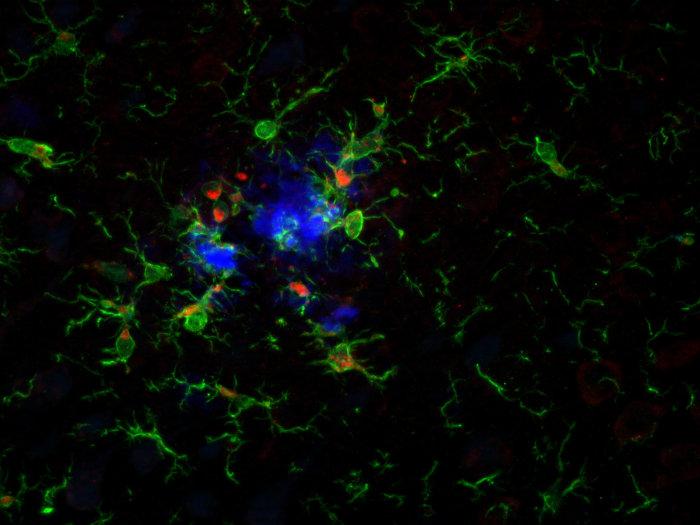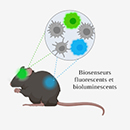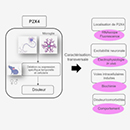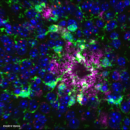Team François RASSENDREN
Purinergic signaling and brain inflammation

The team is interested in the signaling mechanisms involved in neuroinflammatory manifestations with a particular interest in purinergic signaling. In the nervous system glial cells, microglia and astrocytes, are the main immunocompetent cell types. In the event of a breakdown in homeostasis, these cells move from homeostatic to reactive states, characterized by functional remodeling and the acquisition of inflammatory properties. We are interested in these functional remodelings in different acute and chronic pathologies in terms of signaling and transcriptional modifications with the aim of identifying new potential therapeutic strategies.
Purinergic signaling is central in neuron-glia communications. ATP is the main gliotransmitter involved in the regulation of numerous neuronal and glial functions. In pathological conditions, purinergic signaling undergoes significant remodeling with a strong deregulation of the expression of purinergic receptors and an increase in ATP release. This deregulation of purinergic signaling at the level of microglia and astrocytes promotes pro-inflammatory responses.
Our research projects aim to better understand how glial cell signaling is involved in nervous system dysfunctions.
Our work is developed along three main axes:
1- Glial purinergic signaling and inflammation
Glio-transmission is strongly dysregulated in inflammatory conditions. Our interest focuses on the modification of purinergic signaling and its involvement in pro-inflammatory responses. Other recently identified signaling players are also studied.
• Study of the involvement of microglial P2X purinergic receptors in chronic pain and associated comorbidities.
• Understanding the mechanisms of ATP release in pathological conditions (epilepsy, sterile inflammation) through the development of ATP biosensors.
• Relationship between purinergic signaling and inflammasome activation; development of biosensor of IL1ß maturation
2- Inflammation and Alzheimer’s disease
Inflammation caused by microglia is a hallmark of Alzheimer’s disease. This inflammation evolves throughout the development of the pathology and its effects, beneficial or harmful, remain controversial. The team’s data showed that microglial reactivity is present within the parenchyma even before the appearance of amyloid deposits. We are interested in understanding the mechanisms of initiation of the microglial reaction in the context of Alzheimer’s disease. The different axes addressed are:
• Functional roles of Clec7a in the early phases of Alzheimer’s disease.
• Diversity of human microglial cells in Alzheimer’s disease.
• Diversity of microglial cells in a primate model of Alzheimer’s disease.
3- Peripheral immune cells and neuroinflammation
Recent studies demonstrate the recruitment and participation of other types of immune cells in the neuroinflammatory process. In particular, the role of mast cells in neuroinflammatory manifestations is booming. Two axes are addressed:
• Role of mast cells in the early stages of Alzheimer’s disease
• Study of IRAP endosomes as new therapeutic targets in neuroinflammation.
4- Innovative models and tools
To carry out our studies, we rely on innovative models and approaches:
• Development of biosensors applied to inflammation (ATP, IL1ß); BRET and video microscopy
• Murine models of Alzheimer’s disease, in particular the APPNL-F model, an AD knock-in mouse model that expresses a mutated humanized APP.
• High-content transcriptomic analyzes on isolated cells (Nanostring, RNA-seq, and scRNA).
• Translational models, in particular non-human primate models (Collaboration with M. Dhenain, Kremlin-Bicètre) and human induced pluripotent cells (hiPSCs) (Collaboration with C. Crozet, INM, Montpellier)

Reactive microglia (green) clustered around amyloid plaques (blue) express P2X4 receptors (red) in APP/PS1 mice brain.

 IGF Sud 116
IGF Sud 116 04 34 35 92 85
04 34 35 92 85-
2021Authorization to Supervise Research (HDR) - University of Montpellier - France
-
1991PhD - University of Montpellier - France
-
1987DEA in Biology and Health - University of Montpellier - France
-
2009CNRS Research Director - Institute of Functional Genomics (IGF) - Montpellier - France
-
2004CNRS Researcher - Institute of Functional Genomics (IGF) - Montpellier - France
-
1998CNRS Researcher - Institute of Human Genetics (IGH) - Montpellier - France
-
1995-1998Post-doctoral fellow - GlaxoWellcome Research Institute - Geneva - Switzerland
-
1991-1995Post-doctoral fellow - Columbia University - New York - USA
- Head of the Neuroscience Master program, Montpellier University
- Molecular Neurobiologist specialized in ion channels.
- Purinergic signaling
- Neuroinflammation

 IGF Sud 116
IGF Sud 116 04 34 35 92 85
04 34 35 92 85-
2022Habilitation to Supervise Research (HDR)- University of Montpellier - France
-
2008PhD - Neurosciences - University of Montpellier - France
-
2004MSc - Health & Biology - University of Montpellier - France
-
2014-INSERM Researcher - Institute of Functional Genomics - Montpellier - France
-
2013-2014Postdoctoral fellow - University of Geneva - Switzerland
-
2009-2012Postdoctoral fellow - University of Manchester - England
-
2004-2008PhD student - Institute of Functional Genomics - Montpellier - France
-
2018-2023ANR Jeune Chercheur
-
2013-2014Marie Sklodowska-Curie Fellowship-IEF
-
2021-Member of Equipment Committee - Institute of Functional Genomics
-
2018-Co-responsible of L2 laboratory dedicated to virus experimentation - Institute of Functional Genomics
- Main techniques mastered
- Cultures of primary cells and cell lines
- BRET
- Biosensors development
- Imaging (IHC, ICC), live cells imaging (calcium, biosensors)
- Molecular biology, plasmids, PCR, Western Blot, biochemistry
- Design, production and purification of viral particles (lentivirus, AAV)
- Work in BSL2 sector
- Designer Level 1 training
- Data analysis
- GraphPad Prism
- Pack office
- Image J
- Snapgene

 IGF Sud 116
IGF Sud 116 04 34 35 92 85
04 34 35 92 85-
2016Accreditation to supervise research (HDR) - Neurosciences - University Montpellier - France
-
1999PhD in Neurosciences - University Montpellier - France
-
1994MSc in Pharmacology - University Montpellier - France
-
1994Engineer Diploma in Chemistry & Biochemistry - Chemistry Engineering School - Montpellier - France
-
2009-CNRS Faculty Research Scientist - Institute of Functional Genomics (IGF) - Montpellier - France
-
2002-2008CNRS Faculty Research Scientist, Dr A. Privat Team - Institute for Neurosciences (INM) - Montpellier - France
-
1999-2002Postdoctoral fellow (Dir. Pr J.M. Henley) - Department of Anatomy, MRC Centre for Synaptic Plasticity - University of Bristol - England
-
1999Assistant Professor (Dir. J. Vignon) - INSERM U336, Chemistry School - Montpellier - France
-
1994-1999PhD student (Dir. J. Vignon) - INSERM U336, Chemistry School - Montpellier - France
-
2023-Head of GDR "Microglia and Neuroinflammation"
-
2021-Scientific Manager of the RHEM-AdV histology platform (i.e., Montpellier Histology Platform, Arnaud de Villeneuve campus)
-
2019-Member of the GDR "Microglia and Neuroinflammation" steering committee
-
2019-Member of the Glial Cell Club Board, Treasurer
-
2019-Review Editor for Frontiers in Aging Neurosciences
-
2014-Member of the iExplore animal facility steering committee, Arnaud de Villeneuve site; project follow-up & Indexing of murine lines on the animal facility network; bi-monthly meetings
- My overall research interests are to study the pathophysiological mechanisms that lead to neurodegenerative diseases (ND).
- My current researches aim at deciphering the contribution of glial cells, in particular microglial cells, to the initiation and progression of these pathologies, in particular Alzheimer's Disease. More specifically, I aim to characterize the early microglial response and identify its role in ND pathogenesis.
- The ultimate goals of my researches are to identify the microglial molecular signaling pathways involved, and to determine whether these can help identify disease biomarkers or represent targets for the development of innovative therapeutic strategies. We are currently focusing on Clec7a/Dectin-1 receptor, a pattern recognition receptor identified as an important regulator of peripheral inflammation but whose microglial role remains largely unknown.
- To achieve our objectives, we use a wide range of complementary technological approaches, including :
- glial cell purification
- transcriptomic analysis (qPCR, dPC, Nanostring, RNAseq & scRNAseq) on isolated cells
- primary cultures of microglia and hiPSCs (human induced pluripotent stem-cells)
- cellular approaches (phagocytosis, cytokine release)
- histological analyses (IHC, RNAscope)
- behavioral analysis (Barnes-Maze, Open-field; Y-Maze)

 IGF Sud 116
IGF Sud 116 04 34 35 92 85
04 34 35 92 85

 IGF Sud 116
IGF Sud 116 04 34 35 92 85
04 34 35 92 85

 IGF Sud 116
IGF Sud 116 04 34 35 92 85
04 34 35 92 85-
1993University Diploma Bilingual Technician French-German, 3rd language English - Haute Alsace University - Mulhouse - France
-
1992Associate degree of science Applied Biology, Biological and Biochemical Analysis - Claude Bernard University, Lyon I - France
-
2013-Assistant Engineer UM - Team F. Rassendren - Institute of Functional Genomics (IGF) - Montpellier - France
-
2005-2013Technical Assistant UM then Technician UM then Assistant Engineer UM - Team S. Dalle - Institute of Functional Genomics (IGF) - Montpellier
-
2002-2005Technical Assistant UM - INSERM U376 "Physiopathologie de la cellule ß pancréatique et diabète de type II" then UMR 5160 "Centre de Pharmacologie et Biotechnologies pour la Santé" - Montpellier - France
-
1996-2002Technical Assistant UM - UPRES EA 1677 “Biomolecules and Pharmacology of Diabetes” - Montpellier - France
-
1994-1996Laboratory Assistant - Rectorat de Strasbourg - France
-
2017-Member of the IGF shop Committee
-
2022-2023Interim manager of the shop and online shop of the IGF
-
2021-2027Elected ITA representative on the Laboratory Council
-
2005-Technical supervision of thesis, Bachelor and Associate degree of science students
- Cell biology
- development, production and validation of lentiviruses and AAVs
- maintenance of cell lines
- cell transfections
- immunolabelling
- Molecular biology
- DNA and RNA extraction
- RT-PCR
- molecular cloning, plasmid transformation
- nucleic acid quantification and analysis (Nanodrop, Agilent Bioanalyser)
- Bacteriology
- bacterial culture
- preparation of competent bacteria
- bacterial transformation
- Biochemistry
- protein extraction
- protein assay and RIA
- western blot
- Histology
- vibratome section and cryostat
- immunostaining
- Microscopy
- Epi-fluorescence microscope with apotome
- Lab manager / Iconography / Health and safety
- purchase and maintenance of equipment, stock management, orders, supplier contacts, archiving
- management of the team's bio-banks
- iconography for articles and funding applications
- handling pathogens in L2 containment
- handling radioelements
- first aid at work
- Level II Applicant Training obtained in 2007
- Computer skills
- pack office
- imageJ
- Photoshop, Gimp
- illustrator, Inkscape
- Languages
- fluent German, scientific and technical
- fluent scientific and technical English

 IGF Sud 114
IGF Sud 114 04 34 35 92 85
04 34 35 92 85-
2020MSc - Health & Biology - Cognition, Neuroscience and Psychology - University of Tours - France
-
2019BSc - Health & Biology - University of Tours - France
-
2021-PhD Student - Institute of Functional Genomics - University of Montpellier - France
-
2021Internship - Inserm U1253 iBrain - UFR Sciences and Technics - University of Tours - France
- I'm a PhD student, my thesis research aims to identify the molecular mechanisms involved in ATP release by astrocytes in pathological conditions via newly developed genetically encoded ATP optical biosensors.
- Laboratory techniques
- Bacteriology
- Cultures of cell lines and primary cells
- Molecular biology, Western Blot, Extraction biochemical test, IHC, ICC
- Data analysis
- GraphPad Prism
- Mastery of Pack office
- Image J

 IGF Sud 116
IGF Sud 116 04 34 35 92 85
04 34 35 92 85-
2019MSc - Signaling and Integrated Systems in Biology (SSIB) - EPHE PARIS - France
-
2017BSc - Analytical and Experimental Biology (BAE) – IUT Montpellier - France
-
2016DUT (Technical University Diploma) - Biological Engineering - Biological and Biochemical Analysis (ABB) - IUT Montpellier - France
-
2023-PhD student at CBS2 Doctoral School - Institute of Functional Genomics - Montpellier - France
-
2019-2023Research engineer at CNRS (Fixed-term contract) - Institute of Functional Genomics - Montpellier - France
- Technical laboratory skills
- Molecular biology: PCR, qPCR, ddPCR Western blot, RNA purification
- Cell biology: in situ hybridization (RNAscope), immunolabeling, cell culture, glial cell dissociation and purification. Cytometry (Analyzer and Sorter)
- Imaging: Light and fluorescent microscopy: Apotome, confocal
- Data analysis
- GraphPad Prism
- Pack office skills
- Imaris
- FlowJo

 IGF Sud 118
IGF Sud 118 04 34 35 92 20
04 34 35 92 20-
2022-PhD student - Doctoral School ED168, Chemical and Biological Sciences for Health (CBS2), University of Montpellier - France
-
2020-2022Master's degree in Biology and Health, Neuroscience cursus (M1: 1/20 and M2: 1/27) - University of Montpellier - France
-
2018-2020Licence Animal Physiology Animale & Neurosciences (L2 : 6/433 et L3 : 1/139) - University of Montpellier - France
-
2016-2018DUT Biological Engineering, Food and Biological Industries option, University of Lyon 1 - Bourg en Bresse - France
-
2016Scientific Baccalaureate, specializing in Earth Sciences, GOOD mention, dance-study course at the Avignon Conservatory - France
-
2022-Thesis, Institute of Functional Genomics - Montpellier - France
-
2022-2023Biology teacher (64 hours), BUT Génie Biologique - Univ. Montpellier - France
-
2022CNRS engineer (1-month fixed-term contract), Institute of Functional Genomics - Montpellier - France
-
2018Virology laboratory technician (3-month fixed-term contract), Centre Hospitalier Henri Duffaut - Avignon - France
-
2022PhD fellowship from Doctoral School ED168 - Chemical and Biological Sciences for Health (CBS2) (Ranking: 1/80)
- Laboratory Techniques
- Bacteriology
- PCR
- Spinal dorsal root ganglia (DRG) cultures
- Calcium imaging on DRG culture
- Immunohistochemistry
- Electrophysiology coupled with optogenetics on hippocampal slices
- Designer training level 1 & surgery
- Data analysis
- GraphPad Prism
- Mastery of Pack office
- Image J

 IGF Sud 116
IGF Sud 116 04 34 35 92 85
04 34 35 92 85

 IGF Sud 116
IGF Sud 116 04 34 35 92 85
04 34 35 92 85

 IGF Sud 114
IGF Sud 114 04 34 35 93 04
04 34 35 93 04-
2020-2022MSc - Biology and Health, Neurosciences - University of Montpellier - France
-
2017-2020BSc - Life Sciences and Health - University of Tours - France
-
2022-PhD student (CBS2 Doctoral School ) - Institute of Functional Genomics - Montpellier - France
-
2022CNRS engineer (Fixed-term contract) - Institute of Functional Genomics - Montpellier - France
-
2023-Sponsorship France Alzheimer - Paris
-
2022DiapAlz Prize (Montpellier Alzheimer's Club) - Montpellier
-
2022CBS2 Doctoral Dchool grant - University of Montpellier

 IGF Sud 116
IGF Sud 116 04 34 35 92 85
04 34 35 92 85

 IGF Sud 116
IGF Sud 116 04 34 35 92 85
04 34 35 92 85

 IGF Sud 001
IGF Sud 001 04 34 35 92 85
04 34 35 92 85

 IGF Sud 116
IGF Sud 116 04 34 35 92 85
04 34 35 92 85-
2014PhD - Molecular and Translational Medicine - University of Milan - Italy
-
2009Master's degree - Biology - University of Milan - Italy
-
2021-Research engineer - Institute of Functional Genomics - Montpellier - France
-
2018-2021Postdoctoral fellow - Humanitas Research Hospital - Milan - Italy
-
2015-2018Postdoctoral fellow - Université Paris Descartes - Paris - France
-
2010-2014PhD student - Besta Neurological Institute - Milan - Italy
- Main techniques
- Immunohistochemical procedures for light, fluorescent and confocal microscopy
- Electrophysiology
- Live cell imaging (biosensors)
- Behavioral analyses (Open field test, Marble Burying test, Self-grooming test, Prepulse inhibition of startle response test, Light/Dark Chamber, Three chamber social preference test, Rotarod test, Grip and Grid test)
- Analysis of electroencephalographic tracings
- Level 1 designer and surgery training
- Data analysis
- GraphPad Prism
- Image J
- Pack office
- Ponemah and Neuroscore
- Clampfit and Origin

 IGF Sud 114
IGF Sud 114 04 34 35 92 85
04 34 35 92 85
- Nobili P, Ulman L, Rassendren F, Hirbec H*. Limited contribution of the of P2X4 receptor to LPS-induced microglial reaction in mice. Purinergic Signal 2023 Dec 30. doi: 10.1007/s11302-023-09984-5. PMID: 38159160.
- Weimershaus M, Carvalho C, Rignault R, Waeckel-Enee E, Dussiot M, van Endert P, Maciel TT, Hermine O.Mast cell-mediated inflammation relies on insulin-regulated aminopeptidase controlling cytokine export from the Golgi. J Allergy Clin Immunol. 2023 Jun;151(6):1595-1608.e6. doi: 10.1016/j.jaci.2023.01.014. PMID:
- Gilabert D, Duveau A, Carracedo S, Linck N, Langla A, Muramatsu R, Koch-Nolte F, Rassendren F, Grutter T, Fossat P, Boué-Grabot E, Ulmann L. Microglial P2X4 receptors are essential for spinal neurons hyperexcitability and tactile allodynia in male and female neuropathic mice. 2023 Oct 2;26(11):108110. doi: 10.1016/j.isci.2023.108110. PMID: 37860691
- Hua J, Garcia de Paco E, Linck N, Maurice T, Desrumaux C, Manoury B, Rassendren F, Ulmann L. Microglial P2X4 receptors promote ApoE degradation and contribute to cognitive deficits in Alzheimer disease. Cell Mol Life Sci. 2023 May 5;80(5):138. doi: 10.1007/s00018-023-04784-x. PMID: 37145189.
- Chappe YL, Pierredon S, Joushomme A, Molle P, Garenne A, Canovi A, Barbeau S, Poulletier De Gannes F, Hurtier A, Lagroye I, Ducret T, Quignard JF, Compan V, Percherancier Y. Genetically-encoded BRET probes shed light on ligand bias-induced variable ion selectivity in TRPV1 and P2X5/7. Proc Natl Acad Sci USA. 2022 Nov 16;119(46):e2205207119. doi: 10.1073/pnas.2205207119. PMID: 36343259.
- Chappe Y, Michel P, Joushomme A, Barbeau S, Pierredon S, Baron L, Garenne A, Poulletier De Gannes F, Hurtier A, Mayer S, Lagroye I, Quignard JF, Ducret T, Compan V, Franchet C, Percherancier Y. High-Throughput Screening of Transient Receptor Potential Channel 1 Ligands in the Light of the Bioluminescence Resonance Energy Transfer Technique. Mol Pharmacol. 2021 Sep;100(3):237-257. doi: 10.1124/molpharm.121.000271. PMID: 34127538.
- Hemonnot-Girard A L, Meersseman C, Pastore M, Linck N, Rey C, Chebbi A, Jeanneteau J, Ginsberg SD, Lachuer J, Reynes C, Rassendren F, Hirbec H. Comparative analysis of transcriptome remodeling in plaque associated and plaque distant microglia during amyloid-ß pathology progression in mice. J Neuroinflammation. 2022 Sep 24;19(1):234. doi: 10.1186/s12974-022-02581-0. PMID: 36153535
- Ollivier M, Beudez J, Linck N, Grutter T, Compan V, Rassendren F. P2X-GCaMPs as Versatile Tools for Imaging Extracellular ATP Signaling. 2021 Jan 28;8(1):ENEURO.0185-20.2020. doi: 10.1523/ENEURO.0185-20.2020. PMID: 33380526.
- Audinat E, Rassendren F. Glial Mechanisms of Inflammation During Seizures. Inflammation and Epilepsy: New Vistas. Progress in Inflammation Research 2021 Springer International Publishing 88, pp.45-70. doi: 10.1007/978-3-030-67403-8_3
- Hemonnot-Girard AL, Valverde AJ, Hua J, Delaygue C, Linck N, Maurice T, Rassendren F, Hirbec H*. Analysis of CX3CR1 haplodeficiency in male and female APPswe/PSEN1dE9 mice along Alzheimer disease progression. Brain Behav Immun. 2021 Jan;91:404-417. doi: 10.1016/j.bbi.2020.10.021. PMID: 33190798.
- Rassendren F and Audinat E. Purinergic signaling in epilepsy J Neurosci Res. 2016 Sep;94(9):781-93. doi: 10.1002/jnr.23770. PMID: 27302739.

Development of biosensors for the characterization of inflammation
Principal investigator
Vincent COMPAN



• Meersseman Cédric – FRM – 2014-2015
PhD Students
• Damien Gilabert – 2018-2023
• Vincent Seube –2018-2022
• Anne-Laure Hemonnot-Girard – 2017-2021
• Jennifer Hua – 2015-2019
• Matthias Ollivier –2014-2018
• Sarah Lalisse – 2012-2015
Engineers
• Sandra Pierredon – IR 2019-2022
• Valentin Garcia – IE 2019 -2023
Brain Week
• 2024: Glial cells and neurodegenerative diseases – Hélène Hirbec / Matthieu Prieur / Valentin Garcia – Lycée Jean Monnet Montpellier & Lycée des Garrigues St Clément de Rivière
• 2023: Glial cells: neurons don’t work alone! – Hélène Hirbec – Lecture for the general public
• DECLICS – Dialogues Entre Chercheurs et Lycéens pour les Intéresser à la Construction des Savoirs – Find out more
• Hélène Hirbec – since 2019
• François Rassendren – 2022, 2023
UTT – Université du Tiers Temps Montpellier
• • François Rassendren: Neuroinflammation – January 9, 2023 Montpellier – Find out more




